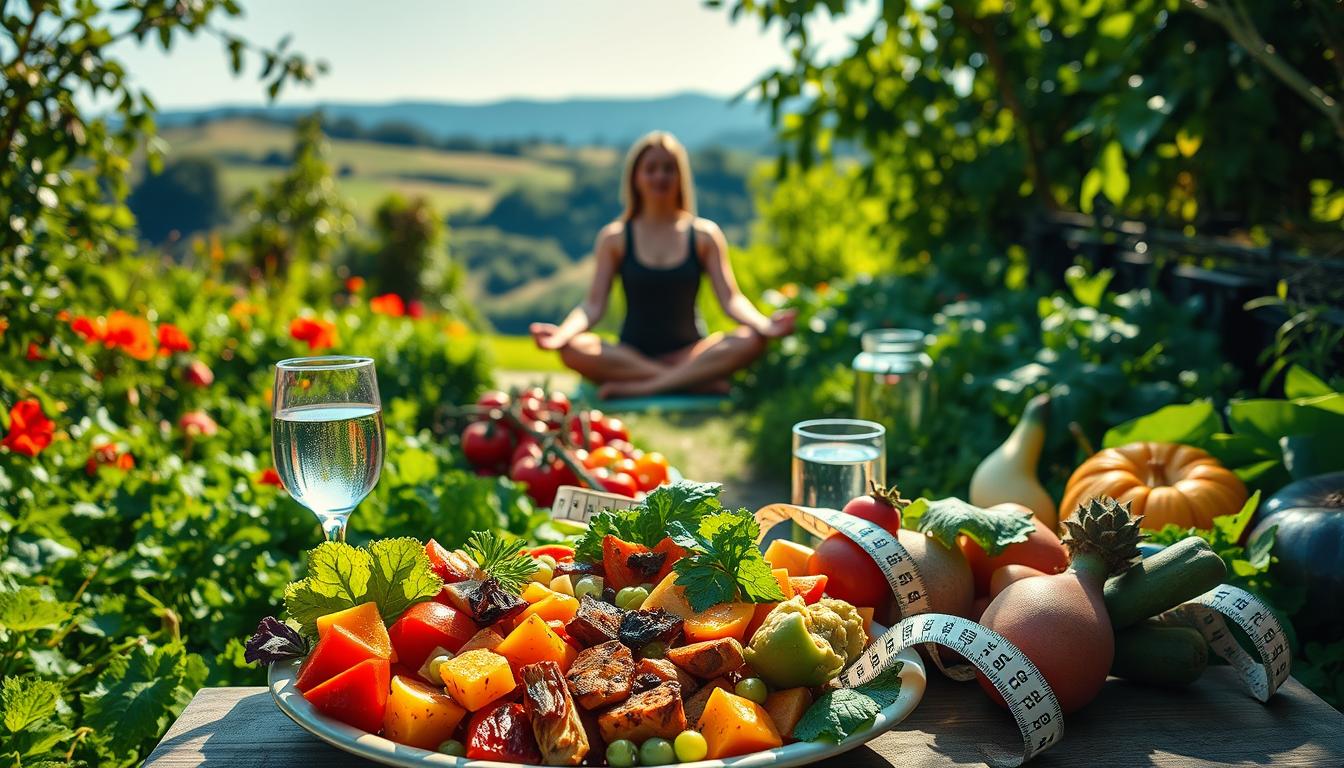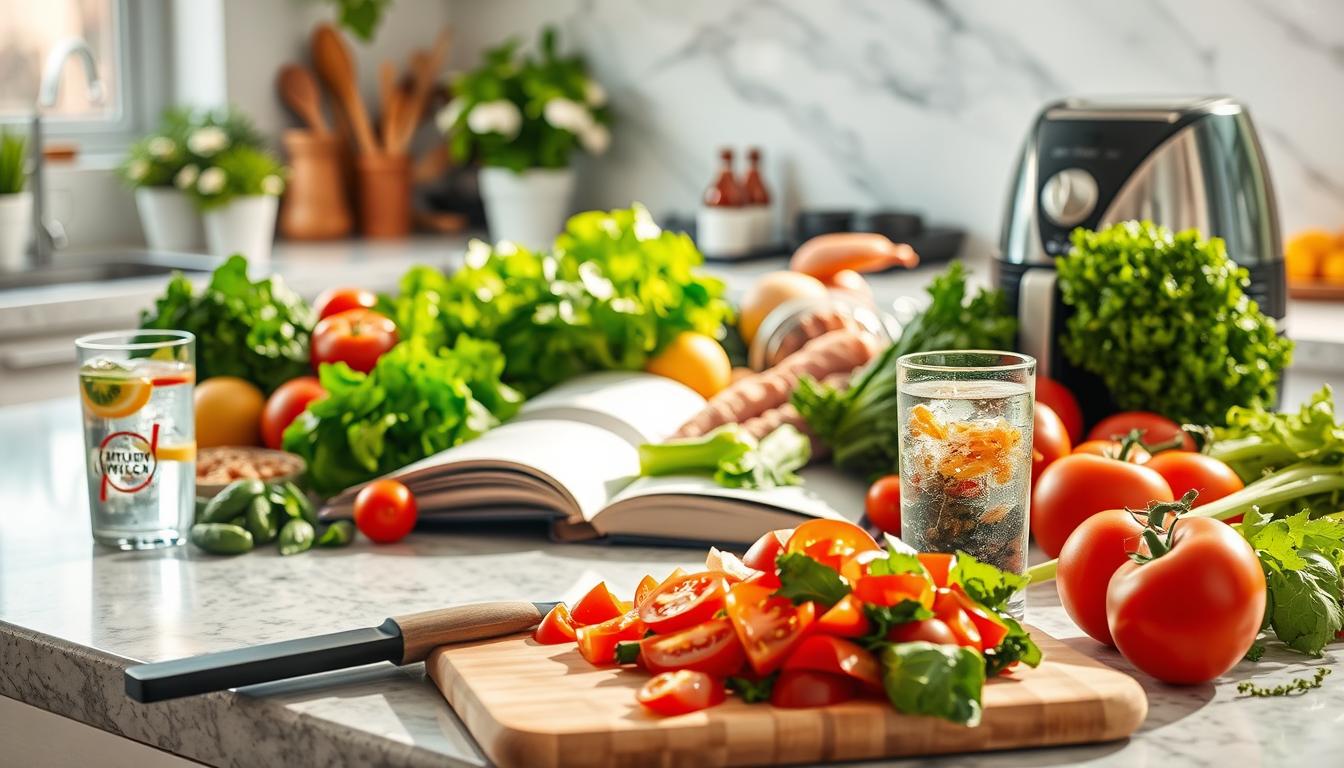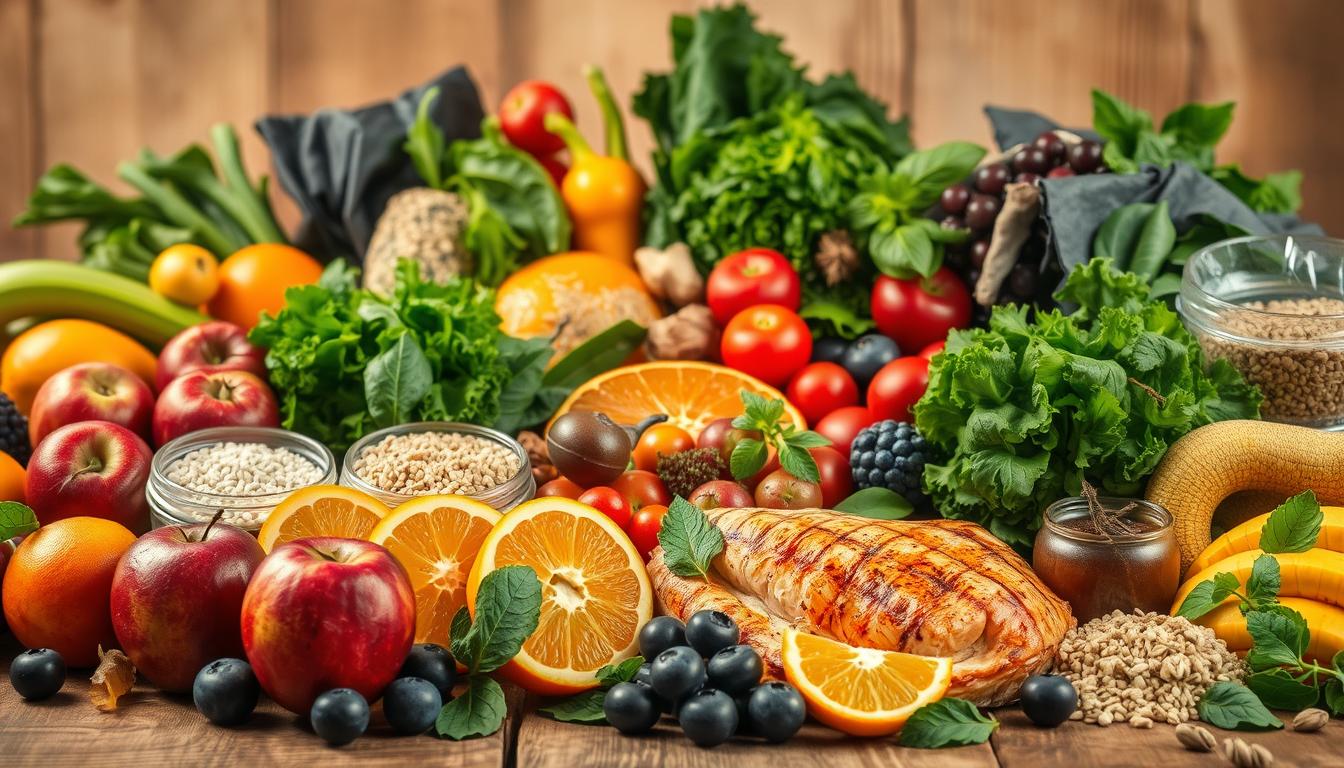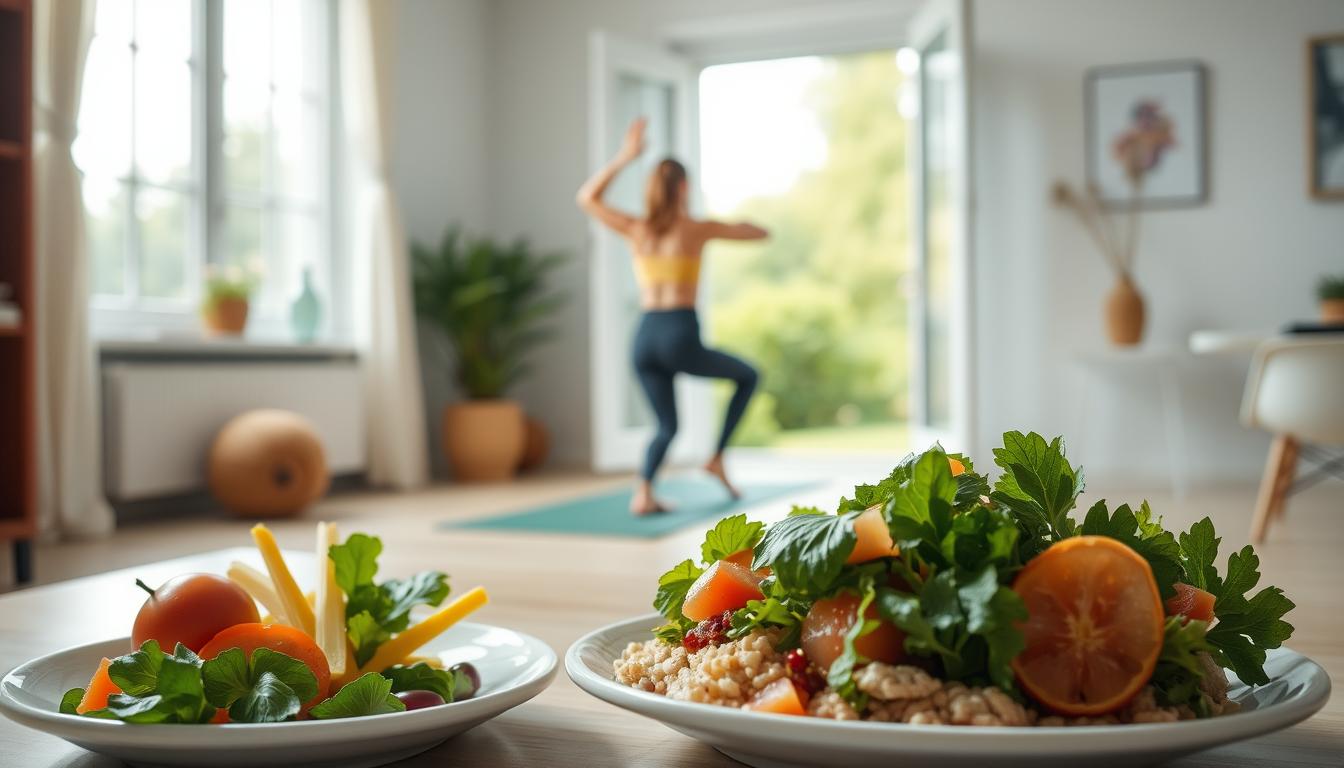Imagine standing in front of the mirror, ready to make a change. That’s where I began my journey. For years, I struggled with diets that left me hungry or overwhelmed. Then I discovered the vegetarian diet for healthy weight loss.
By focusing on whole foods like leafy greens, beans, and colorful veggies, I not only shed pounds but also felt energized. This isn’t just about losing weight—it’s about building a lifestyle that nourishes your body and soul.
Key Takeaways
- A vegetarian diet prioritizes nutrient-rich foods to support sustainable weight loss.
- Learning how to lose weight on a vegetarian diet involves balancing flavors and fullness.
- Plant-based eating can enhance energy levels while reducing calorie intake.
- Simple swaps like swapping meat for lentils or tofu create lasting habits.
- This approach focuses on long-term health, not short-term fixes.
Understanding the Basics of a Vegetarian Diet
Choosing the right vegetarian approach starts with clarity. The benefits of vegetarian diet for weight loss depend on selecting a plan that aligns with your goals and preferences. My journey showed that understanding the options is the first step toward sustainable change.
Definition and Types of Vegetarianism
A vegetarian diet excludes meat, but variations exist. Here’s a breakdown:
| Type | Allowed Foods | Key Points |
|---|---|---|
| Lacto-Ovo | Dairy, eggs | Includes common staples like cheese and yogurt. |
| Lacto | Dairy only | Avoids eggs but includes milk and cheese. |
| Ovo | Eggs only | Focuses on plant foods plus egg-based proteins. |
| Vegan | No animal products | Strictest form, requires careful nutrient planning. |
Nutritional Benefits of a Vegetarian Diet
Plant-based eating naturally reduces calorie-dense foods while boosting nutrients. Key advantages include:
- Lower saturated fat intake: Fewer animal products mean less artery-clogging fats.
- Higher fiber content: Fruits, veggies, and whole grains promote fullness and stable blood sugar.
- Rich in phytonutrients: Plant compounds like antioxidants support metabolism and reduce inflammation.
These factors make the benefits of vegetarian diet for weight loss both science-backed and personally achievable.
How a Vegetarian Diet Supports Weight Loss
The science behind the benefits of vegetarian diet for weight loss is simple. It’s all about low caloric density and high fiber content. By eating whole foods, I found that plant-based diets help with weight loss. This approach makes it easy to eat fewer calories without feeling hungry.
Discover the Secret to Fast Weight Loss!
Low Caloric Density
Plant-based foods are full of nutrients but low in calories. For instance:
- Leafy greens like kale and spinach add bulk to meals without adding excess calories.
- Vegetables like zucchini or mushrooms replace higher-calorie ingredients in dishes like stir-fries or burgers.
- Fruits such as watermelon or grapefruit provide hydration and natural sugars without the calorie spikes of processed snacks.
High Fiber Content
Fiber-rich foods keep me full longer by slowing digestion. My meals now focus on:
- Whole grains like brown rice or barley in main dishes.
- Legumes such as black beans or lentils for hearty soups and salads.
- Snacks like roasted chickpeas or apple slices with almond butter.
Using these strategies leads to a lasting way to lose weight with plant-based weight loss. Swapping a cheese omelet for a spinach-and-tomato scramble or choosing a pear over chips makes a big difference. The body stays full while eating fewer calories, helping to reach weight goals.
Key Nutrients to Focus On
Building a vegetarian diet for healthy weight loss means focusing on nutrients that fuel your body without excess calories. I learned the hard way that skipping key vitamins or protein can stall progress—here’s what works.
Protein Sources for Vegetarians
Plant-based protein is crucial for maintaining muscle while shedding fat. My go-to’s include:
- Legumes like lentils and chickpeas (15g protein/cup)
- Firm tofu (10g protein/½ cup)
- Quinoa (8g protein/cup cooked)
- Nuts/seeds (almonds, chia) as snack staples
Pair grains with beans for complete amino acids—rice and black beans, for example.
Essential Vitamins and Minerals
Iron and B12 were my biggest hurdles. I now:
- Choose iron-rich foods: spinach, fortified cereals, and pair with vitamin C (oranges, bell peppers) to boost absorption
- Take a B12 supplement (I use NOW Foods’ sublingual tablets) since plants lack natural B12
- Incorporate zinc from pumpkin seeds and omega-3s via flaxseeds
Regular blood tests helped me track deficiencies—don’t skip them when adjusting your vegetarian diet for healthy weight loss.
Meal Planning for Weight Loss Success
Starting a vegetarian diet for weight loss begins with planning. I aim for balance and simplicity to prevent hunger and nutrient gaps. I plan each meal to keep me full without focusing too much on calories.
Burn Fat & Boost Your Metabolism!
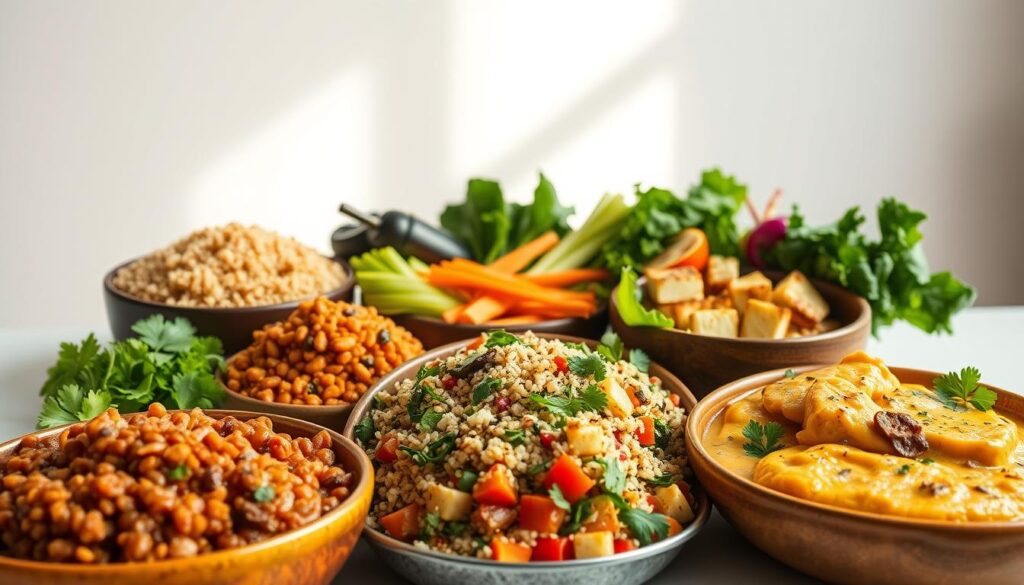
Creating Balanced Meals
I follow the plate method to make sure my meals are satisfying. Half my plate is filled with non-starchy veggies like broccoli or spinach. A quarter is for protein: tofu, lentils, or chickpeas. The last quarter is whole grains like quinoa or brown rice. This balance helps control carbs and boosts my metabolism.
- Batch prep staples: I keep cooked grains and beans in my fridge for quick meals.
- Roasted veggie trays: Having pre-chopped veggies saves time during busy weeks.
Importance of Portion Control
Portion sizes are crucial. Here are some tips to avoid overeating:
- Right-size your plate: Using a 9-inch plate helps keep portions in check.
- Measure once, guess later: I portioned my meals for a week to learn the right serving sizes.
- Mindful eating: I enjoy each bite and pause to check if I’m still hungry.
By following these steps, portion control became second nature. My vegetarian diet for weight loss is now easy, not hard.
Smart Grocery Shopping Tips
Learning to shop smart is crucial for a vegetarian weight loss plan. These tips changed how I shop, focusing on foods that help me reach my goals without breaking the bank.
Choosing Whole Foods
I start by focusing on the store’s perimeter. This is where you find fresh produce and bulk bins. Here’s what I put in my cart:
- I fill up on seasonal veggies and fruits first. They’re cheaper and packed with nutrients.
- I choose whole grains like brown rice or farro instead of refined ones. They keep me full longer.
- I buy dried beans and lentils in bulk. They’re affordable and full of protein.
Reading Nutrition Labels
Even vegetarian foods can hinder weight loss. Here’s how I stay on track:
- I look for products with 5 ingredients or fewer to avoid additives.
- I compare sodium levels, aiming for under 300mg per serving.
- I check sugar content. I avoid products with added sugars over 5g per serving.
These tips help me avoid empty calories and keep my meals in line with my weight loss goals. Planning my shopping trip and list helps me stay focused. Now, my cart shows my commitment to health and ethics.
Delicious and Healthy Vegetarian Recipes
Exploring the best vegetarian recipes for weight loss has been crucial for me. Each dish combines protein, fiber, and taste without too many calories. Here are my favorites:
Breakfast Ideas
- Overnight oats: Mix rolled oats with almond milk, chia seeds, and protein powder. Add fresh berries and flaxseeds on top.
- Tofu scramble: Sauté tofu with turmeric, spinach, and roasted red peppers for a tasty start.
Lunch Options
My top picks for lunch include:
- Quinoa salad bowls: Mix cooked quinoa with chickpeas, cucumber, tomatoes, and lemon-tahini dressing.
- Stuffed bell peppers: Fill with brown rice, black beans, corn, and avocado crema for a quick meal.
Dinner Favorites
| Meal | Ingredients | Calories (per serving) |
|---|---|---|
| Vegetable Stir-Fry | Bok choy, mushrooms, tofu, sesame oil | 350 |
| Chickpea Curry | Chickpeas, coconut milk, turmeric, spinach | 320 |
| Zucchini Noodles | Zucchini, basil pesto, cherry tomatoes, pine nuts | 280 |
These recipes focus on whole foods like tofu, legumes, and veggies. They keep portions full but low in calories. Using protein sources like tempeh or lentils helps control hunger. I measure serving sizes to meet my goals without losing enjoyment.
Overcoming Challenges in Maintaining a Vegetarian Diet
Starting a vegetarian diet for weight loss needs planning and flexibility. Here’s how I turned challenges into chances to keep going:
Social Situations and Eating Out
- Look up menus before going to find vegetarian choices.
- Bring snacks like roasted chickpeas to avoid bad choices.
- Tell people about your plant-based goals: “I’m eating more plants for health.”
Combating Cravings
It’s easy to want meat or junk food. My trick? Swap it with plant-based options:
| Craving | Vegetarian Substitute |
|---|---|
| Meat-based meals | Mushroom “bacon” or lentil “meatballs” |
| Cheese | Cashew-based sauces or nutritional yeast |
| Snacks | Rice cakes with hummus or roasted edamame |
Keeping up means making changes when needed. If I hit a wall, I try:
- Eating more fiber with leafy greens
- Less sugar in smoothies
- Adding 10-minute walks every day
These tips helped me stay on track. Small swaps, like choosing snap peas over chips, made a big impact.
Incorporating Physical Activity
Exercise is key when you’re on a how to lose weight on a vegetarian diet plan. I mix strength training and cardio to lose fat and keep muscle.

Types of Exercises that Complement a Vegetarian Diet
Strength training is my base. I lift weights, use resistance bands, or do push-ups to build muscle. For cardio, I cycle or walk briskly to burn calories and improve heart health. Yoga and stretching help me stay flexible and avoid injuries.
- Strength Training: Dumbbell workouts, bodyweight exercises
- Cardio: Running, swimming, or dancing
- Flexibility: Yoga poses and dynamic stretches
Setting Realistic Fitness Goals
I start small and track my progress every week. Here’s how I stay on track:
- Begin with 30-minute workouts 3x weekly
- Gradually increase intensity (e.g., adding 5 minutes to cardio sessions)
- Focus on milestones like lifting heavier weights or finishing a 5K
My meals support my workouts. After exercising, I eat tofu stir-fry or chickpea snacks to recover. Combining exercise with the how to lose weight on a vegetarian diet plan helps me build lasting habits. Each workout boosts my confidence, making weight loss seem within reach.
Staying Motivated on My Weight Loss Journey
Keeping up with a vegetarian diet for healthy weight loss needs smart plans. Here’s how I stay on track:
Keeping a Food Journal
Tracking meals helps me see what hinders my progress. I use these ways:
- App-based logging with MyFitnessPal to count macros
- Photo journals to check portion sizes
- Weekly reflection to tweak my choices
Seeking Support from Friends and Family
| Strategy | Example |
|---|---|
| Join a community | Local veggie meetups or Forks Over Knives forums |
| Meal prep swaps | Inviting family to try tofu stir-fries instead of meat dishes |
| Accountability buddy | Sharing progress updates with a workout partner |
Wins like fitting into old jeans or feeling more energetic motivate me. Celebrating these victories keeps me focused on my vegetarian diet for healthy weight loss goals.
The Role of Hydration in Weight Loss
Staying hydrated is a simple yet powerful step for plant-based weight loss. Water keeps metabolism active and helps curb mindless snacking. My journey showed that even mild dehydration can slow down fat-burning processes, making hydration a priority.

Importance of Drinking Water
- Drink 16-20 oz of water upon waking to kickstart metabolism
- Hydration reduces calorie intake by reducing hunger confusion
- Carry a reusable bottle to track daily intake (aim for 8-10 cups)
Herbal Teas and Their Benefits
Infusions like green tea and dandelion root add variety while supporting goals. I discovered:
| Tea Type | Key Benefits | Serving Tips |
|---|---|---|
| Green Tea | Increases fat oxidation | Sip 2 cups daily |
| Peppermint | Aids digestion after meals | Cool in summer, warm in winter |
| Chamomile | Reduces nighttime cravings | Enjoy caffeine-free before bed |
Avoid sugary plant-based beverages like fruit juices. I replaced them with sparkling water and unsweetened infusions to cut 200+ empty calories daily. Small changes like adding lemon slices or mint leaves made staying hydrated enjoyable without added sugars.
Recognizing Sustainable Weight Loss
Creating a vegan diet for weight loss that lasts is about steady progress, not quick fixes. I learned that lasting change comes from setting realistic goals. Instead of aiming for fast weight loss, I set targets like losing 1-2 pounds a week. This pace is shown to lead to long-term success.
Goal-Setting Strategies
- Base goals on body metrics, not just numbers on a scale.
- Incorporate non-scale wins like improved energy or fitness milestones.
- Adjust goals quarterly to match changing needs and progress.
Tracking Beyond the Scale
I track progress through:
- Weekly measurements and photos to monitor body shape changes.
- Journaling mood and energy levels to gauge overall wellness.
- Checking fitness benchmarks like push-up reps or run times.
Plateaus are a normal part of the journey. When I hit a plateau, I recalculate my calorie needs and adjust my protein intake. Adding a 12-hour fasting window helps reset my metabolism without extreme cuts. Maintenance phases, where I pause active weight loss to stabilize at a new weight, have helped me stay on track with the vegan diet for weight loss. It’s about consistency, not perfection, that makes this lifestyle sustainable.
Final Thoughts on My Vegetarian Diet Journey
Starting a plant-based diet for weight loss taught me that real change is about adopting a new lifestyle. It’s not just about losing weight. It’s about building habits that match my values and health goals. This journey has changed my life in many ways.
Embracing a Lifestyle Change
Switching to a plant-based weight loss approach changed how I see food. I moved away from counting calories and focused on eating whole foods. This made meals feel like a gift, not a burden.
Choosing lentils over junk food and trying new recipes became part of my daily life. Seeing it as a lifestyle, not just a diet, made it sustainable.
Celebrating Small Victories
Small wins, like eating well for a week or hiking further, kept me going. These victories showed me that progress is not always straight. Every step is important.
These successes boosted my confidence. They made bigger goals, like running a 5K or mastering tofu stir-fries, seem reachable.
My journey went beyond just losing weight. Learning about sustainable farming and sharing meals with friends deepened my connection to food and community. For those starting, remember: the vegan diet for weight loss is about feeling good, making smart choices, and living a healthier, more intentional life.
FAQ
What is the best vegetarian diet for healthy weight loss?
Can I lose weight effectively on a vegan diet?
What are some practical vegetarian meal plans for weight loss?
What tips do you have for vegetarian weight loss?
What are the benefits of a vegetarian diet for weight loss?
What are some of the best vegetarian recipes for weight loss?
How can I successfully lose weight on a vegetarian diet?
Did you like this article? See also: https://powerfitguide.com/how-to-lose-weight-without-losing-muscle-mass/

